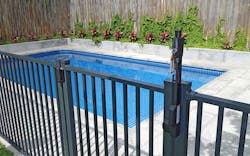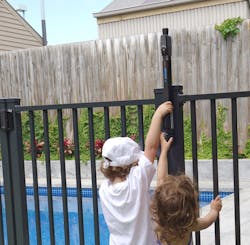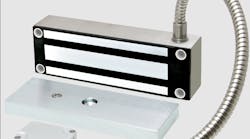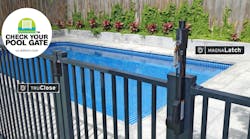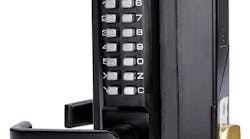Drowning is the leading cause of death in children ages 1–4 years, and the majority of the children who drown in swimming pools most commonly gain access to the pool area through a faulty fence or gate.
Combined with constant child supervision and other layers of protection, physically checking your pool gate and maintaining your pool gate regularly to ensure it self-closes and self-latches at all times could help to prevent drownings. You shouldn’t be able to open a gate without activating the release mechanism, which should be out of the reach of toddlers. In addition, the gate should close and latch without assistance.
D&D Technologies, the inventor and manufacturer of the MagnaLatch Pool Safety Gate Latch, has joined with the National Drowning Prevention Alliance (NDPA) to establish the Check Your Pool Gate Month campaign during May. The initiative was created to remind pool owners of the vital necessity to ensure pool fences, gates, latches and hinges are secure, operate correctly and incorporate multiple layers of protection to help to secure the pool area from unauthorized entry. Every pool owner should be confident they have a safe swimming zone.
“Our goal with Check Your Pool Gate Month is to educate pool owners about pool safety and to encourage them to check their pool surroundings not once a year, but regularly,” says Jim Paterson, D&D’s senior vice president of sales and marketing.
It’s critical to check your local pool codes for compliance, because local codes might vary.
A few minutes is all it takes for pool owners to check that their pool fences and gates are in good working order. This simple routine done regularly could help to save the life of a child.
● Gates should open outward, away from the pool.
● The latch-release knob should be out of reach of toddlers under 5 years of age. (Check local codes or standards for minimum requirements.)
● Fencing should be at a minimum height to comply with your region and encompass the pool area. (Check local codes or standards for minimum requirements.)
● Gates must be self-closing and self-latching.
● The fence perimeter should have adequate distance from other climbable objects or structures.
● Gate hinges should be reliable, tension-adjustable, self-closing and rust-free.
● The latch can’t be key-locked in the “open” position.
● The latch can’t be opened through the use of implements or force.
● The latch must be adjustable horizontally and vertically to accommodate gate movement.
● Maximum clearance from the finished ground surface should be no more than 4 inches (100mm).
● The gate should latch from any position.
● The gate must comply with all relevant codes or standards and legislation for pool safety.
● You should incorporate multiple layers of protection: https://ndpa.org/layers-of-protection/.
For more information on pool safety and compliance, visit: www.us.ddtech.com and www.ndpa.org.
